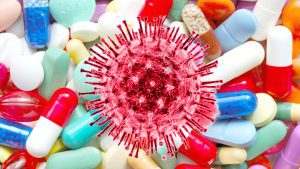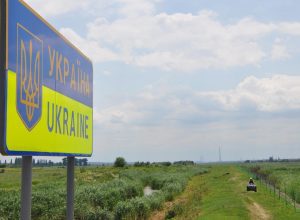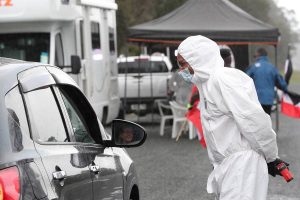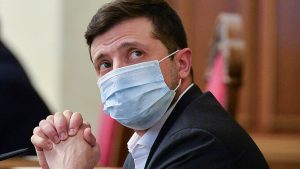
India has donated 50,000 capsules of the OMVIR antiviral drug, which is used to treat patients with COVID-19, as humanitarian aid to Ukraine, the Ministry of Health reports.
According to the report, these medications will be enough to treat about 5,000 patients.
“Ukraine is very grateful for the humanitarian aid of 50,000 capsules of the OMVIR preparation. This drug is included in the domestic treatment protocol and our hospitals, identified as supporting in the fight against COVID-19, are very interested in receiving it. This lot is enough to treat about 5,000 patients,” Ihor Ivaschenko, the Deputy Minister of Health for European Integration, said.
Ambassador of India to Ukraine Partha Satpathy noted that, if necessary, there may be additional deliveries of this drug.

The Health Ministry of Ukraine has allowed clinical testing of four domestic medicines with the aim of studying their effectiveness for patients diagnosed with coronavirus (COVID-19).
These medicines include Amizon Max, Amixin IC, Bioven and Corvitin, Health Minister of Ukraine Maksym Stepanov said during a press briefing on Monday.
“Some clinical trials are at the final stage. As soon as results are obtained, conclusions on a possibility of using these medicines for treatment of the coronavirus disease will be made,” the ministry said.
The Health Ministry also monitors the information about the development of COVID-19 vaccines in the world. There is no such vaccine at the moment. AstraZeneca has announced its plans to produce the vaccine. Four countries (Germany, France, Italy and the Netherlands) have created an alliance and preordered the vaccine.
“Ukraine has also addressed these countries with a request for putting our country on the priority list for obtaining the vaccine when it appears,” the ministry said.

The Irish low cost airline Ryanair (Dublin) has asked the passengers before a trip to confirm that they got acquainted with the restrictions introduced in the destination country. “During an online check-in, passengers are directed to the ‘Ryanair COVID-19 travel restrictions page’ where they must confirm that they are familiar with the existing restrictions before receiving a boarding pass,” Interfax-Ukraine was told in Ryanair on Tuesday.
Moreover, the airlines reported that before the trip the passengers were asked to fill and provide additional travel documents.Ryanair advises customers before flying to check the latest travel restrictions and requirements in a particular country.
“The 12 passengers of the Ryanair flight Kyiv-Athens (July 4) were denied entry to Athens in accordance with the current restrictions of the Greek government for non-EU citizens. Affected customers were rebooked for the next available flight to Kyiv,” the airlines said.
As reported, the group of 17 Ukrainians who were not allowed into Greece on Saturday, July 4, are to return to Ukraine on Tuesday, said Head of the Consular Service Department of the Foreign Ministry of Ukraine Serhiy Pohoreltsev.

The decrease in the number of cases of coronavirus (COVID-19) disease in Ukraine over the last three days has led to the stabilization of important indicators of the epidemic in Ukraine after a month of continuous growth.
According to the Health Ministry, in particular, the maximum average daily morbidity for two weeks in the first wave of the epidemic was 474 patients and was recorded on the day of the start easing lockdown, on May 10, and the second maximum of 547 patients was on June 29. There was a local minimum between them of 382 patients on May 29.
According to the Health Ministry, on May 29, Ukraine also reached the local minimum of a weekly average daily incidence of 375 patients after the first peak of 476 patients on early May. After almost a month of continuous growth, a new peak of 917 patients was reached on June 27.
These figures fell to 840 patients (an average figure over two weeks) and some 855 patients (an average figure over a week) by early July.
The World Health Organization (WHO) indicates that the length of time between the moment of COVID-19 infecting and the symptoms onset is usually about five to six days, but can vary from one to 14 days. In almost all countries, the number of registered cases on weekend falls significantly for administrative reasons. Therefore, the world uses daily average morbidity diagrams for the last one and two weeks.
Among other indicators that have stabilized in recent days, the number of hospitalized people per day is the following: some 201 patients on average over a week and some 187 patients on average over two weeks, whereas before that they had almost continuously increased from 100 to 110 patients in late May and early June.
The growth of such indicator as the ratio of the number of cases to the number of PCR tests averaged over the week also stopped.
The graphs reflecting the number of deaths from COVID-19 disease are fluctuating strongly as before. On June 28, they reached their maximum indicator since the start of the epidemic, namely, almost 18 people on average over two weeks or more than 19 people on average over a week, but in the last three days they have been declining, having returned to the level of early May.
However, it is still not possible to stop another important plot – the number of people infected with COVID-19 at present.
As a result, Ukraine entered the government-defined “red” disease zone with over 40 patients per 100,000 populations with a current value of this indicator of about 58 patients.

Sociologists have conducted a survey among Ukrainians, during which they suggested choosing which of the allegations about the origin of coronavirus and its worldwide spread is true to a greater extent. Some 66% of respondents believe in the artificial origin of coronavirus.
The Kyiv International Institute of Sociology (KIIS) in late May – early June asked respondents of the survey to choose among the following options: (1) natural occurrence and subsequently spread in the world; (2) artificial development in the laboratory, but random distribution in the world; (3) special development and deliberate distribution in the world to reduce the population and/or damage to individual countries. In addition, respondents could name their option.
Most respondents – one in three, 37% – chose the option that the coronavirus was “specially designed and intentionally distributed in the world to reduce the population and/or damage individual countries.” Another 29% chose the option that the coronavirus “was made artificially in the laboratory, but its worldwide spread was an accident.”
Only 18% chose the option that the coronavirus appeared naturally and then spread worldwide.
Respondents who chose the option of artificial origin, but accidentally distributed in the world, were asked the additional question “In which country, in your opinion, was the coronavirus artificially made?” The question was posed in an open form, that is, the respondent was not offered any answers.
“The vast majority of respondents (70%) believe that coronavirus was artificially developed in China. Another 5% called the United States, and 3% called Russia.
At the same time, respondents who chose the option “coronavirus was specially designed and intentionally distributed in the world to reduce the population and/or damage to individual countries” asked an additional question: “Who, in your opinion, is responsible for the development and intentional spread of coronavirus?” The question was also posed in an open form, that is, the respondent was not offered any answers.
“Half of the respondents (49%) found it difficult to answer the question. However, 26% believed that China was responsible for the development and deliberate distribution of coronavirus. The United States (11%) and Russia (with 2%) followed. Other answers were less common,” the information says.
KIIS conducted a CATI survey (using a computer assisted telephone interviews) based on a random sample of mobile phone numbers from May 31 to June 4, 2020. The sample is representative of the adult population (aged 18 years and older) of Ukraine. The sample does not include Russia-occupied areas in Donbas and Crimea.
During the survey, 2,000 interviews were conducted. The statistical error of the sample (with a probability of 0.95 and taking into account the design effect of 1.1) does not exceed: 2.2% for indicators close to 50%, 2.1% for indicators close to 25%, 1.4% – for indicators close to 10%.

Ukrainian President Volodymyr Zelensky has said he himself is not afraid of the coronavirus, and that even wanted to fall ill with the disease in order to show Ukrainians what it is like, but later abandoned the idea. “I wanted to go through it myself. To make it easier for people. Once when we were all depressed, we got together and I suggested, ‘Let me fall ill with the disease and immediately isolate myself at Bankova [the street on which the President’s Office is located]. I will survive the disease and show people what it is like. I wanted to do this so people would understand it is not the plague and that we will all die [of COVID-19],” Zelensky said in an interview with the Ukrainska Pravda ezine on June 3-4.
The president said he later abandoned the idea because “it was too much.”
“It was not difficult to do. But, of course, my family wouldn’t have forgiven me. They would have said I am crazy. And, in principle, they would have been right,” the president said.